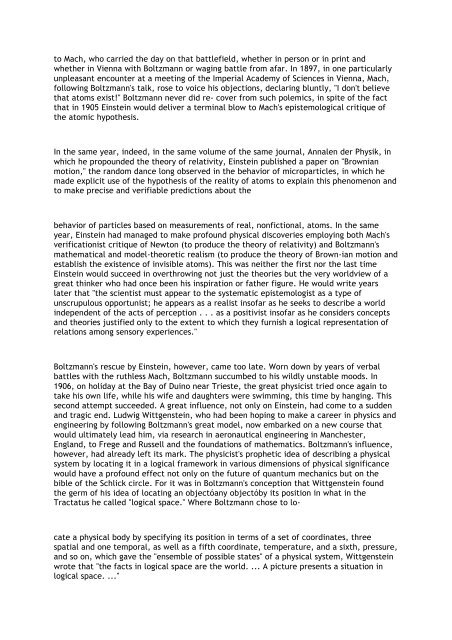Yourgrau P. A world without time.. the forgotten legacy of Goedel and Einstein (Basic Books, 2005)(ISBN 0465092934)(176s)_PPop_
Yourgrau P. A world without time.. the forgotten legacy of Goedel and Einstein (Basic Books, 2005)(ISBN 0465092934)(176s)_PPop_
Yourgrau P. A world without time.. the forgotten legacy of Goedel and Einstein (Basic Books, 2005)(ISBN 0465092934)(176s)_PPop_
You also want an ePaper? Increase the reach of your titles
YUMPU automatically turns print PDFs into web optimized ePapers that Google loves.
to Mach, who carried <strong>the</strong> day on that battlefield, whe<strong>the</strong>r in person or in print <strong>and</strong><br />
whe<strong>the</strong>r in Vienna with Boltzmann or waging battle from afar. In 1897, in one particularly<br />
unpleasant encounter at a meeting <strong>of</strong> <strong>the</strong> Imperial Academy <strong>of</strong> Sciences in Vienna, Mach,<br />
following Boltzmann's talk, rose to voice his objections, declaring bluntly, "I don't believe<br />
that atoms exist!" Boltzmann never did re- cover from such polemics, in spite <strong>of</strong> <strong>the</strong> fact<br />
that in 1905 <strong>Einstein</strong> would deliver a terminal blow to Mach's epistemological critique <strong>of</strong><br />
<strong>the</strong> atomic hypo<strong>the</strong>sis.<br />
In <strong>the</strong> same year, indeed, in <strong>the</strong> same volume <strong>of</strong> <strong>the</strong> same journal, Annalen der Physik, in<br />
which he propounded <strong>the</strong> <strong>the</strong>ory <strong>of</strong> relativity, <strong>Einstein</strong> published a paper on "Brownian<br />
motion," <strong>the</strong> r<strong>and</strong>om dance long observed in <strong>the</strong> behavior <strong>of</strong> microparticles, in which he<br />
made explicit use <strong>of</strong> <strong>the</strong> hypo<strong>the</strong>sis <strong>of</strong> <strong>the</strong> reality <strong>of</strong> atoms to explain this phenomenon <strong>and</strong><br />
to make precise <strong>and</strong> verifiable predictions about <strong>the</strong><br />
behavior <strong>of</strong> particles based on measurements <strong>of</strong> real, nonfictional, atoms. In <strong>the</strong> same<br />
year, <strong>Einstein</strong> had managed to make pr<strong>of</strong>ound physical discoveries employing both Mach's<br />
verificationist critique <strong>of</strong> Newton (to produce <strong>the</strong> <strong>the</strong>ory <strong>of</strong> relativity) <strong>and</strong> Boltzmann's<br />
ma<strong>the</strong>matical <strong>and</strong> model-<strong>the</strong>oretic realism (to produce <strong>the</strong> <strong>the</strong>ory <strong>of</strong> Brown-ian motion <strong>and</strong><br />
establish <strong>the</strong> existence <strong>of</strong> invisible atoms). This was nei<strong>the</strong>r <strong>the</strong> first nor <strong>the</strong> last <strong>time</strong><br />
<strong>Einstein</strong> would succeed in overthrowing not just <strong>the</strong> <strong>the</strong>ories but <strong>the</strong> very <strong>world</strong>view <strong>of</strong> a<br />
great thinker who had once been his inspiration or fa<strong>the</strong>r figure. He would write years<br />
later that "<strong>the</strong> scientist must appear to <strong>the</strong> systematic epistemologist as a type <strong>of</strong><br />
unscrupulous opportunist; he appears as a realist ins<strong>of</strong>ar as he seeks to describe a <strong>world</strong><br />
independent <strong>of</strong> <strong>the</strong> acts <strong>of</strong> perception . . . as a positivist ins<strong>of</strong>ar as he considers concepts<br />
<strong>and</strong> <strong>the</strong>ories justified only to <strong>the</strong> extent to which <strong>the</strong>y furnish a logical representation <strong>of</strong><br />
relations among sensory experiences."<br />
Boltzmann's rescue by <strong>Einstein</strong>, however, came too late. Worn down by years <strong>of</strong> verbal<br />
battles with <strong>the</strong> ruthless Mach, Boltzmann succumbed to his wildly unstable moods. In<br />
1906, on holiday at <strong>the</strong> Bay <strong>of</strong> Duino near Trieste, <strong>the</strong> great physicist tried once again to<br />
take his own life, while his wife <strong>and</strong> daughters were swimming, this <strong>time</strong> by hanging. This<br />
second attempt succeeded. A great influence, not only on <strong>Einstein</strong>, had come to a sudden<br />
<strong>and</strong> tragic end. Ludwig Wittgenstein, who had been hoping to make a career in physics <strong>and</strong><br />
engineering by following Boltzmann's great model, now embarked on a new course that<br />
would ultimately lead him, via research in aeronautical engineering in Manchester,<br />
Engl<strong>and</strong>, to Frege <strong>and</strong> Russell <strong>and</strong> <strong>the</strong> foundations <strong>of</strong> ma<strong>the</strong>matics. Boltzmann's influence,<br />
however, had already left its mark. The physicist's prophetic idea <strong>of</strong> describing a physical<br />
system by locating it in a logical framework in various dimensions <strong>of</strong> physical significance<br />
would have a pr<strong>of</strong>ound effect not only on <strong>the</strong> future <strong>of</strong> quantum mechanics but on <strong>the</strong><br />
bible <strong>of</strong> <strong>the</strong> Schlick circle. For it was in Boltzmann's conception that Wittgenstein found<br />
<strong>the</strong> germ <strong>of</strong> his idea <strong>of</strong> locating an objectóany objectóby its position in what in <strong>the</strong><br />
Tractatus he called "logical space." Where Boltzmann chose to lo-<br />
cate a physical body by specifying its position in terms <strong>of</strong> a set <strong>of</strong> coordinates, three<br />
spatial <strong>and</strong> one temporal, as well as a fifth coordinate, temperature, <strong>and</strong> a sixth, pressure,<br />
<strong>and</strong> so on, which gave <strong>the</strong> "ensemble <strong>of</strong> possible states" <strong>of</strong> a physical system, Wittgenstein<br />
wrote that "<strong>the</strong> facts in logical space are <strong>the</strong> <strong>world</strong>. ... A picture presents a situation in<br />
logical space. ..."


